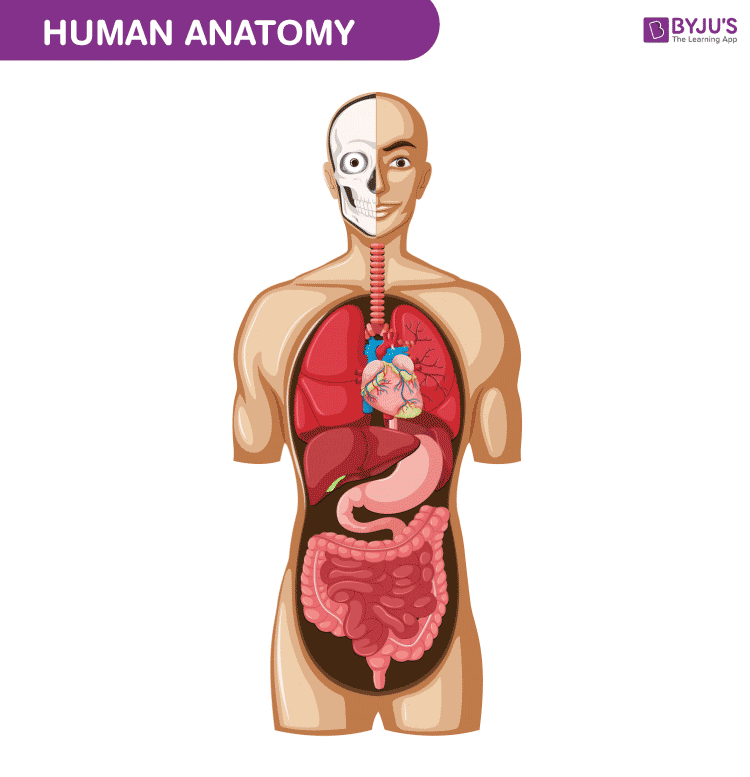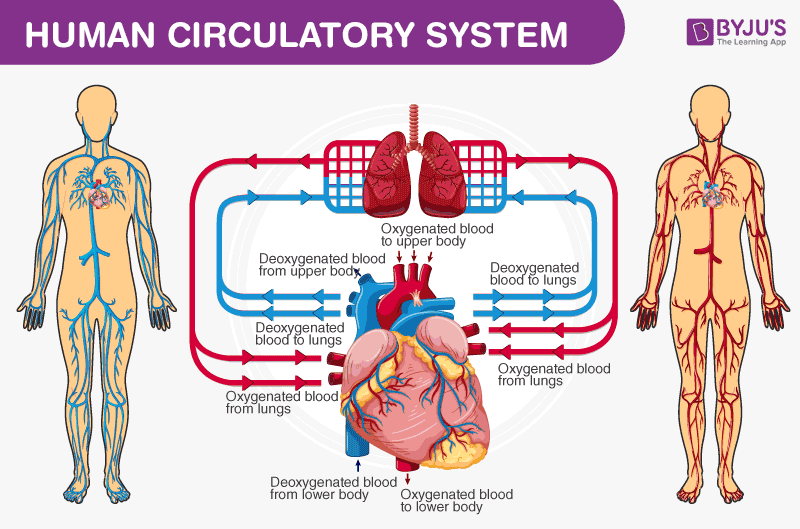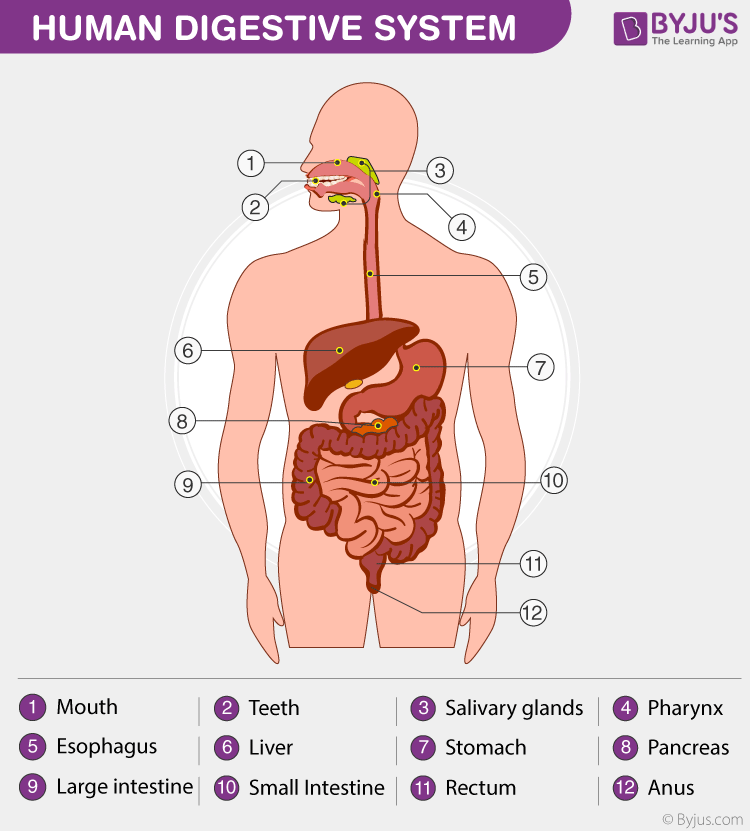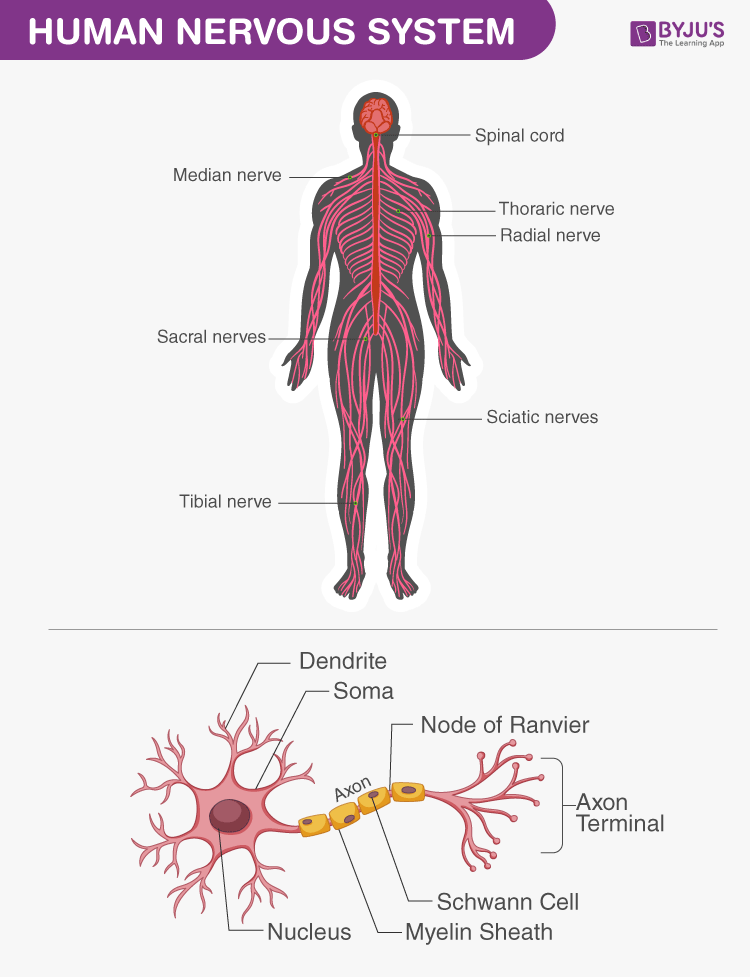About Human Body
If we were to “break apart” the human body at the microscopic level, then the cell would constitute its most basic unit.
The average adult has somewhere between 30 – 40 trillion cells, and an estimated 242 billion new cells are produced every day. When a select group of cells with similar functions come together, it forms a tissue.
Tissues cumulate into organs, group of organs form organ systems and eventually, a complete organism.
Cells -> Tissues -> Organs -> Organ System -> Organism
Human Anatomy
Skeleton
The human body exhibits a variety of movements from walking and running to crawling, jumping and climbing. The framework that enables us to do all these activities is the skeleton. Humans have as much as 300 bones at birth. However, the bones start to fuse with age. At adulthood, the total number of bones is reduced to 206.

Human Anatomy is the scientific study of form and shapes of human beings
The skeleton also protects several vital organs such as the heart, lungs and the liver. Bones are attached to other bones through ligaments, a fibrous connective tissue.
Joints are the points at which two or more bones meet. They enable a range of movements like rotation, abduction, adduction, protraction, retraction and more. Based on flexibility and mobility, joints can be further classified into movable joints and immovable joints. Movable joints are flexible while immovable joints (also called fixed joints) are non-flexible since the bones are fused.
Muscles
Muscles are specialised tissues which assist the bones in locomotion. Muscles are attached to the bones through tendons. Movement of limbs happens due to the contraction and relaxation of the corresponding muscles present in that region. Joints help in the flexibility of bones, but a bone cannot be bent or stretched until a muscle acts on it. In other words, the muscles attached to that bone pulls it to the direction of movement.
Furthermore, most movement involves muscles that work as a pair. For example, when we bend our arm, muscles in that region contract, become shorter and stiffer and pull the bones to the direction of movement. For relaxation (stretching), muscles in the opposite direction have to pull the bones towards it.
Also Read: What is Liver
List of Human Body Parts
- Human body parts comprise a head, neck and four limbs that are connected to a torso.
- Giving the body its shape is the skeleton, which is composed of cartilage and bone.
- Human body internal parts such as the lungs, heart, and brain, are enclosed within the skeletal system and are housed within the different internal body cavities.
- The spinal cord connects the brain with the rest of the body.
Human Body Structure
There are different cavities in the human body that house various organ systems.
- The cranial cavity is the space within the skull, it protects the brain and other parts of the central nervous system.
- The lungs are protected in the pleural cavity.
- The abdominal cavity houses the intestines, liver and spleen.
Humans have evolved separately from other animals, but since we share a distant common ancestor, we mostly have a body plan that is similar to other organisms, with just the muscles and bones in different proportions.
For example, we might assume giraffes have more vertebrae in its neck than humans. No, despite being incredibly tall, giraffes have the same number of vertebrae, i.e. they also have seven vertebrae in their neck.
One of the most prominent characteristic features is the ability to use our hands, especially for tasks that require dexterity, such as writing, opening a bottle of water, opening a doorknob, etc.
This is the result of humans having ancestors that began walking on their hind limbs rather than using all four limbs. Most of our anatomical insight was gained through the dissection of corpses (cadavers), and for a long time, it was the only way we could gain anatomical knowledge about the human body. It was a rather grotesque affair, but it made up the bulk of medical literature for centuries. These days, technological innovation has made it possible to explore human anatomy at a microscopic level.
Even to this day, scientists are newly discovering organs that were previously overlooked or have been mistakenly identified as other existing tissues. In 2018, scientists had discovered a new, body-wide organ called the Interstitium that exists right under the skin.
Human Physiology
It is referred to the physical, mechanical, and biochemical function of humans. This connects health, medicine, and science in a way that studies how the human body acquaints itself to physical activity, stress, and diseases.
The person who is trained to study human physiology is called a physiologist. Claude Bernard is referred to as the father of Physiology for his exemplary research.
Read More: Physiology
Human Body Parts and their Functions
The list of human body parts vary as the standard definition of an organ is still up for debate. However, there are an estimated 79 organs identified to date. We also possess organs that have “lost” their function throughout our evolution. Such organs are called vestigial organs.
Some of these organs work together and form systems that are specialised to perform a specific function or a set of functions. Collectively, these are known as organ systems.
And out of these 79 organs, five are crucial for survival, and any damage to these five organs might result in termination of life. These five crucial human body parts are the brain, heart, liver, lungs and kidneys. Read on to explore more about these body parts and their functions in detail:
Circulatory System
The circulatory system is also referred to as the cardiovascular system. It comprises the heart and all the blood vessels: arteries, capillaries, and veins. There are essentially two components of circulation, namely:
- Systemic circulation
- Pulmonary circulation

Diagram showing pulmonary (blue) and systemic circulation (red)
Besides these two, there is a third type of circulation called Coronary circulation. Because blood is the body’s connective tissue, it helps to transport essential nutrients and minerals to the cells and waste byproducts away from it.
Hence, it is also known as the body’s “transport system.” Anatomically, the human heart is similar to other vertebrate hearts in the animal kingdom and hence, is a homologous organ.
Also Read: Double Circulation
Digestive System

A diagram of the human digestive system detailing various components
The digestive system breaks down food and assimilates nutrients into the body, which the body then uses for growth and cell repair.
The major components of the digestive system are:
- Mouth
- Teeth
- Tongue
- Oesophagus
- Stomach
- Liver
- Pancreas
- Gastrointestinal tract
- Small and large intestines
- Rectum
The process of digestion starts with mastication (chewing food). Then, the saliva mixes with food and forms a bolus, a small rounded mass that can be easily swallowed. Once swallowed, the food travels down the oesophagus and into the stomach. The stomach secretes strong acids and powerful enzymes that break the food down into a paste.
It then moves into the small intestine where the food is broken down even more because of the bile secreted by the liver and powerful, digestive enzymes from the pancreas. This is the stage at which nutrients are absorbed from the food.
The leftover materials (stool) then move on to the large intestine where it transforms from liquid to solid, as water is removed. Finally, it gets pushed into the rectum, ready to be eliminated from the body.
Explore: The Structure and Function of the Alimentary Canal
Reproductive System
The human reproductive system is also known as the genital system that comprises internal and external organs that help in reproduction. It varies for both males and females. Hormones, fluids, and pheromones are all connective accessories for the reproductive organs to function.
Female Reproductive System
The female reproductive system consists of the following:
- Ovaries: Produces ovum – female egg as well as the hormone estrogen.
- Uterine tubes: Oviducts or fallopian tubes are the other names given for uterus tubes.
Also known as the womb, the uterus is a pear-shaped organ where the fetus grows. The cervix is the route to the vagina and gateway for sperm to enter. Vagina acts as the route for a penis to enter during intercourse and the exit of the fetus during delivery.

Male Reproductive System
The male reproductive system consists of testicles, which act as a storehouse for sperms. These oval-shaped organs, are encased in a pouch that is called scrotum.

Next to the testis is the vas deferens that are the accessory ducts for the male sexual system. When sperm is formed, it is mixed with fluids that are produced by seminal glands, prostate gland, and Cowper’s gland. The primary purpose of Cowper gland is to hike the semen volume and lubrication during coitus.
More to Explore: Reproductive System
Respiratory System
The respiratory process involves the intake of oxygen, and the exhale of carbon dioxide from the body. This system is also known as the ventilatory system, gas exchange system or respiratory apparatus. Vertebrates like human beings possess lungs for respiration. The process of respiration starts with the cycle of inhalation and exhalation.
Inhalation results in the oxygen entering into the body and exhalation results in carbon dioxide exiting from the body. Anatomically, the respiratory system comprises the following organs:
- Trachea
- Bronchi
- Bronchioles
- Lungs
- Diaphragm

A diagram of the human respiratory system highlighting the gas exchange process
By diffusion, molecules of carbon dioxide and oxygen are exchanged passively among the blood cells and external environment. This swap is done through alveoli (which are the air sacs) in the lungs.
More About: Respiratory System
Nervous System
The voluntary and involuntary actions are maintained and taken care of by the central nervous system. It helps to channel the signals to and from different parts of our body. Nervous System is broadly classified into two categories:
- Central Nervous System
- Peripheral Nervous System

Distribution of Nerves in humans (top) and the Neuron (bottom)
The central nervous system contains the brain and the spinal cord, while the peripheral nervous system includes nerves and ganglia that are present outside the brain and spinal cord. Through the axons, every part of the body gets connected.
Central Nervous System consists of:
- Forebrain: It comprises the cerebrum, hypothalamus, and thalamus. The largest part of the brain is the cerebrum. Thinking, perceiving, controlling motor function, receiving and processing information and understanding language are the main functions done by this section of the brain. Also, sexual development and emotion functions are attached to the fore-brain.
- Midbrain: It is situated between the hypothalamus and thalamus. The brain stem is associated with the midbrain. Auditory and visual responses are controlled by the mid-brain.
- Hindbrain: The medulla, pons, and cerebellum are together, tied in the hind-brain. Interconnections of different parts of the brain’s surface that helps to accommodate neurons and connect them to the spinal column are done by the Hind brain.
Peripheral Nervous System consists of:
- Somatic nervous system: The system’s primary purpose is to transmit the motor and sensory impulses from CNS and back. It is linked to all the sensory organs, limbs and skeletal system. Imagine a scenario where you are riding a bicycle, and suddenly, you spot an obstacle (say a dog) on the road. Your ability to immediately swerve out of the obstacle’s path and avoid the crash is the result of the somatic nervous system taking action.
- Autonomic Nervous System: This system works without the person’s effort. The system helps to relay impulse from the central nervous system to smooth muscles and involuntary organs such as your heart, lungs etc. Also, it prepares the body against any violent attacks or abnormal conditions such as high body temperature during a fever or high rate of breathing and blood pressure after a strenuous exercise.
Further Reading: Nervous System
Key Points About the Human Body
Every human being, tissues, human body parts and the organ systems are made up of cells- the fundamental unit of life. Anatomy is the science of understanding the structure and the parts of living organisms. Physiology, on the other hand, deals with the internal mechanisms and the processes that work towards sustaining life.
These can include biochemical and physical interactions between various factors and components in our body. With the progress of evolution, organisms began to exhibit advanced characteristics and features that enabled them to be more efficient and thrive in their respective environment.
The human structure can be described as bipedal, with hair covering the body, presence of mammary glands and a set of extremely well-developed sense organs. With respect to human body anatomy, we have a specialized circulatory system that enables the efficient transport of materials and nutrients within the body.
The presence of a well-developed digestive system helps to extract essential nutrients and minerals required by the body. A well developed respiratory system ensures the efficient gas exchange and the nervous system enables coordination and interaction within the body and also the external environment, thereby ensuring survival.
Frequently Asked Questions on Human Anatomy And Physiology
What do you mean by human anatomy?
What do you understand by human physiology?
Who is the father of human physiology?
What is the importance of human physiology?
Who is the father of human anatomy?
What are the different types of anatomy?
How is human anatomy relevant?
How are anatomy and physiology different from each other?
What are the important organs of the human body?
What are the different systems of our body?
For more information about human body, human body parts, or any other related topic, please visit BYJU’S Biology.


Excellent 😊 app 👍👍 all students should learn from this app.
It’s very beneficial such a clear-cut app👍
Byju’s is a very good app, it is very simple learning app
It is very interesting app
Byjus helps me learn better. I like science classes
Byjus us the best platform for learing childrens can explore many different types of curriculam and its very benefical too childrens concept and doubts are cleared very easily and appropriately.
The best teachers over here thank you soo much for helping as my phone is not working i am not able to give thumps up ..
Great App. Very lucid language to understand. Also, videos help assuming before a teacher. Very useful. I will definitely recommend students/ parents to Byjus.
It’s so intresting